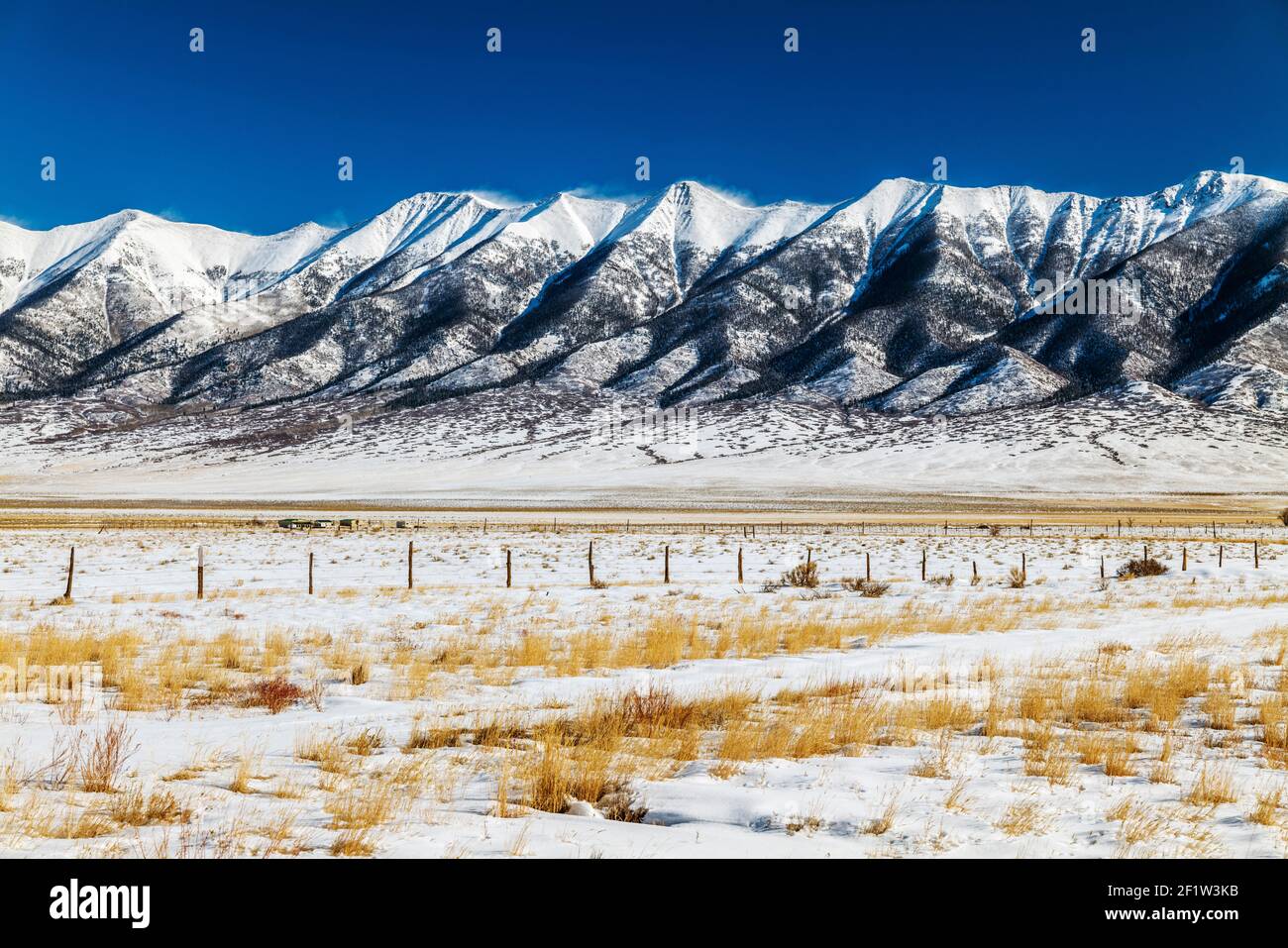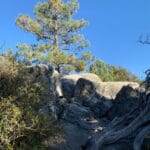Nestled in the heart of the American Southwest, the Sangre de Cristo Mountains stand tall, their peaks glowing crimson at sunset, a spectacle that inspired their very name – “Blood of Christ.” But these mountains offer far more than just a stunning vista; they beckon adventurers, history buffs, and those seeking solace in nature’s grandeur. From challenging climbs to family-friendly trails, the Sangre de Cristo range holds something for every soul. Join us as we explore their hidden treasures, uncover ancient stories, and discover why these mountains continue to captivate all who wander beneath their gaze.
Unveiling the Majesty: An Introduction to the Sangre de Cristos
The Sangre de Cristo Mountains, a captivating subrange of the southern Rocky Mountains, sprawl across a vast expanse, painting a dramatic masterpiece across the canvas of southern Colorado and northern New Mexico. Imagine towering peaks piercing the clouds, pristine forests teeming with life, and crystal-clear streams cascading through valleys carved over millennia.
How Did These Mountains Rise?
The Sangre de Cristos weren’t always the giants we see today. Millions of years ago, the earth’s tectonic plates engaged in a slow, powerful dance, pushing and pulling, causing the land to buckle and fold. This process, known as the Laramide Orogeny, gradually lifted the earth’s crust, shaping the dramatic peaks and valleys that characterize the range. What sets the Sangre de Cristos apart is their unique “fault-block” structure – a geological fingerprint that distinguishes them from other Colorado ranges.
Reaching for the Heavens: Peaks and Elevations
Dominating the skyline, the Sangre de Cristos boast over 14 peaks that soar above 14,000 feet, their summits often lost in a veil of clouds. Among them reigns Blanca Peak, the undisputed monarch of the range and the highest point in all of Colorado. Ascending these peaks is a feat for experienced mountaineers, a test of endurance and skill. But those who conquer the climb are rewarded with breathtaking vistas that stretch as far as the eye can see – a panorama of nature’s artistry.
From Lush Forests to Alpine Tundra: A Climate Mosaic
The Sangre de Cristos encompass a world of their own, their climate as diverse as their landscape. At the base, lush forests embrace the slopes, a symphony of green hues, where sunlight filters through a canopy of leaves. As you ascend, the air grows thin and crisp, the landscape transforming before your eyes. Wildflower meadows erupt in a riot of color, giving way to groves of aspen trees that shimmer in the breeze. Higher still, you enter the realm of the alpine tundra, a world of stark beauty where only the hardiest life forms endure.
A Playground for Adventure: Recreation in the Sangre de Cristos
For outdoor enthusiasts, the Sangre de Cristo Mountains are a paradise beckoning exploration. Whether you’re a seasoned hiker seeking challenging trails, a backpacker eager to lose yourself in the wilderness, or a rock climber drawn to vertical conquests, there’s an adventure here with your name on it.
Trails for Every Soul
The Sangre de Cristos offer a network of trails catering to all skill levels. For a gentle introduction, choose a well-maintained path that meanders through forests and meadows, leading to scenic overlooks or hidden waterfalls. If you crave a challenge, embark on a multi-day backpacking trip, venturing deep into the wilderness, where solitude and breathtaking vistas await. And for those who prefer two wheels, mountain biking trails crisscross the lower elevations, offering an exhilarating way to experience the range’s beauty.
Beyond the Trails: Exploring by Water and Rock
The adventure doesn’t end on land. The Sangre de Cristos are home to pristine alpine lakes, perfect for kayaking or canoeing, their still waters reflecting the majesty of the surrounding peaks. Anglers can cast their lines into crystal-clear streams, hoping for a bite from elusive trout. And for adrenaline junkies, whitewater rafting offers a thrilling ride through rushing rapids.
A Climber’s Paradise
The dramatic rock formations of the Sangre de Cristos have long attracted climbers from around the world. From beginner-friendly crags to challenging multi-pitch routes, there’s something here to test every climber’s skill and courage. Experienced climbers can even attempt to summit some of the range’s iconic fourteeners, pushing their limits amidst breathtaking scenery.
Nature’s Tapestry: Wildlife and Ecosystems
Beyond their rugged beauty, the Sangre de Cristo Mountains teem with life. As you explore their trails and hidden corners, keep your eyes peeled for the creatures that call this place home.
Majestic Creatures of the Mountains
Look skyward for the chance to spot a bald eagle soaring overhead, its wingspan a testament to its power. In the forests and meadows, you might encounter a herd of elk, their majestic antlers silhouetted against the skyline. And if you’re incredibly lucky (or perhaps unlucky!), you might catch a glimpse of a mountain lion, its sleek form blending seamlessly with the surroundings.
Biodiversity at Every Elevation
The varied ecosystems of the Sangre de Cristos support a remarkable diversity of life. From the tiniest insects to large mammals, each creature plays a vital role in maintaining the delicate balance of nature. Wildflowers paint the meadows in a kaleidoscope of colors, attracting pollinators that buzz from bloom to bloom. As you ascend, the vegetation changes, adapting to the harsher conditions, a testament to the resilience of life.
Echoes of the Past: History and Culture
The Sangre de Cristo Mountains are steeped in history, their peaks and valleys bearing witness to the stories of those who came before.
Ancient Footprints: Indigenous Heritage
For centuries, Native American tribes have considered these mountains sacred, their lives intertwined with the rhythm of the seasons. The Jicarilla Apache and the various Puebloan peoples, including the Taos and Picuris Pueblos, have called this area home for generations. Their presence can still be felt today in the petroglyphs etched into rocks, the remnants of ancient dwellings, and the stories passed down through generations.
The Arrival of the Spanish: A Name is Born
In the 16th century, Spanish explorers ventured into the region, drawn by rumors of gold and driven by a thirst for conquest. It was during this era that the mountains acquired their evocative name. Legend has it that in 1719, a Spanish explorer named Antonio Valverde y Cosio, upon witnessing the sunrise cast the snow-capped peaks in a brilliant red hue, exclaimed, “Sangre de Cristo!” (“Blood of Christ!”). Whether inspired by the alpenglow’s resemblance to blood or a reflection of the explorers’ religious zeal, the name stuck, forever linking the mountains to the drama of that moment.
A Complex Tapestry: Acknowledging Layers of History
While the name “Sangre de Cristo” is widely recognized today, it’s essential to acknowledge the complex history it represents. The arrival of the Spanish ushered in an era of colonization that profoundly impacted the indigenous peoples of the region. Their lands were encroached upon, their cultures disrupted, and their stories often marginalized. As we explore and appreciate the beauty of the Sangre de Cristos, it’s crucial to remember and honor the indigenous communities who have long considered these mountains sacred, recognizing the resilience of their cultures in the face of adversity.
Off the Beaten Path: Discovering Hidden Gems
While popular trails and scenic overlooks offer their own allure, the true magic of the Sangre de Cristos often lies in the unexpected discoveries. Venture off the beaten path, and you’ll be rewarded with hidden treasures that will leave you breathless.
Pristine Alpine Lakes
Imagine stumbling upon a hidden alpine lake, its surface a mirror reflecting the sky, the surrounding peaks like guardians of its tranquility. These secluded havens offer a sense of peace and solitude, inviting you to linger by their shores and soak in the beauty of your surroundings.
Secluded Canyons
Centuries of wind and water have sculpted the Sangre de Cristos, carving out hidden canyons that feel like portals to another time. Venture into their depths, and you’ll be surrounded by towering rock walls, adorned with ferns and mosses, the air cool and damp. Keep an eye out for waterfalls cascading down the cliffs, their roar a symphony of nature’s power.
Ancient Whispers: Petroglyphs and Ruins
Scattered throughout the range are reminders of the people who lived here long ago. Ancient petroglyphs, etched into rock faces, offer a glimpse into the beliefs and stories of indigenous cultures. Explore further, and you might stumble upon the remnants of ancient dwellings, their foundations slowly being reclaimed by nature. These archaeological treasures provide a tangible link to the past, inviting us to ponder the lives of those who came before.
Planning Your Sangre de Cristo Adventure
Ready to experience the magic of the Sangre de Cristo Mountains? Here are some tips to help you plan an unforgettable trip.
When to Visit
The Sangre de Cristos offer year-round beauty, each season painting the landscape in a different light. Spring brings wildflowers and gushing waterfalls, summer offers ideal hiking weather, autumn transforms the aspens into a sea of gold, and winter blankets the peaks in snow, perfect for skiing and snowshoeing.
Getting There
The Sangre de Cristo Mountains are accessible from various towns and cities in both Colorado and New Mexico. Major airports in Denver, Colorado Springs, and Albuquerque offer convenient gateways to the region.
Respecting the Land
As you explore the Sangre de Cristos, remember that you are a guest in a delicate ecosystem. Practice Leave No Trace principles by packing out everything you pack in, staying on designated trails, and respecting wildlife. Help preserve the beauty of these mountains for generations to come.
Key Points:
- The Sangre de Cristo Mountains, located in the southern Rocky Mountains, are characterized by towering peaks and deep valleys resulting from tectonic activity.
- The range boasts over 14 peaks exceeding 14,000 feet, including Blanca Peak, the highest point in Colorado.
- The climate varies from lush forests at the base to alpine tundra at higher elevations.
- The mountains offer a wide range of recreational activities, including hiking, backpacking, and rock climbing.
- They are home to diverse wildlife, including eagles, elk, and mountain lions.
- The Sangre de Cristos hold historical significance for Native Americans and were named by Spanish explorers.
- Hidden gems within the range include pristine alpine lakes, secluded canyons, and ancient petroglyphs.
Where is Sangre de Cristo Mountains?
Unveiling the Spine of the Southwest: Where are the Sangre de Cristo Mountains?
Stretching over 250 miles, the Sangre de Cristo Mountains form the southernmost subrange of the Rocky Mountains, gracing southern Colorado and northern New Mexico with their majestic presence. Imagine a giant’s spine, running southeast from central Colorado, crossing the state line, and reaching towards the horizon just east of Santa Fe, New Mexico. That’s the scale and grandeur of the Sangre de Cristos.
This isn’t just a single, continuous ridge. Think of it more like a series of interconnected ranges, each with its own character and charm. In Colorado, the heart of the range boasts the Sangre de Cristo Wilderness, protecting pristine alpine lakes and challenging peaks. Hop across the border into New Mexico, and you’ll find yourself in the Pecos Wilderness, a land of rushing streams, deep canyons, and forests that seem to whisper ancient secrets.
A Road Trip Through Grandeur
Starting at Poncha Pass in Colorado, a drive south along the Sangre de Cristo Scenic Byway is a journey through ever-changing beauty. Towering peaks pierce the sky, their slopes painted with aspens that shimmer gold in the fall. Deep canyons, carved by eons of erosion, plunge towards the valley floor, offering glimpses into the geological heart of the range. And in spring, meadows erupt in a riot of wildflowers, a testament to nature’s artistry.
Four Seasons of Adventure:
- Summer: Hikers and backpackers flock to the Sangre de Cristos, drawn by the promise of challenging trails and breathtaking views. Alpine lakes, nestled amongst the peaks, offer a refreshing escape from the summer heat.
- Fall: The aspens put on a spectacular show, their leaves turning from green to gold, painting the mountainsides in vibrant hues. Scenic drives and hikes become even more awe-inspiring.
- Winter: The Sangre de Cristos transform into a winter wonderland, perfect for skiing, snowboarding, snowshoeing, and backcountry adventures.
- Spring: As the snow melts, wildflowers begin to bloom, painting the meadows in a kaleidoscope of colors. Waterfalls, fed by melting snowpack, roar to life, creating a symphony of sound.
A Legacy Etched in Stone:
The Sangre de Cristos are more than just a pretty face; they’re a place where history and nature intertwine. For centuries, indigenous people, including the Jicarilla Apache and various Puebloan peoples, have called these mountains home. Their stories are woven into the very fabric of the land, from the petroglyphs etched on canyon walls to the ruins of ancient dwellings.
Later, Spanish explorers arrived, leaving their own mark on the region and giving the range its evocative name, “Sangre de Cristo” – “Blood of Christ.” While the exact origin of the name is debated, it likely stems from the alpenglow, that magical moment when the rising or setting sun bathes the peaks in a crimson hue.
Today, the Sangre de Cristo Mountains stand as a testament to the enduring power of nature. They are a place of adventure, solitude, and breathtaking beauty, inviting us to reconnect with the wildness that lies within us all.
Why is it called Sangre de Cristo?
Blood-Red Peaks? The Fascinating Origin of the “Sangre de Cristo” Name
The Sangre de Cristo Mountains. Even the name rolls off the tongue with an air of mystery and drama. Translating to “Blood of Christ,” it evokes vivid imagery, hinting at a story that’s as captivating as the peaks themselves.
A Sunrise Spectacle & a Spanish Explorer
Our journey to unravel the name’s origin takes us back to 1719. Antonio Valverde y Cosio, a Spanish explorer venturing north into what is now southern Colorado, is greeted by a sight that stops him in his tracks. As the sun rises, it casts its golden rays across the snow-capped peaks, bathing them in a vibrant, almost ethereal red. Overwhelmed by the sight’s intensity, Cosio is said to have exclaimed, “Sangre de Cristo!”
Thus, the mountains were christened with a name as striking as the landscape itself. This legend, passed down through generations, has cemented itself in the region’s identity. But as with many tales from the past, the true origin likely involves a more nuanced tapestry of interpretations.
Beyond the Literal: Symbolism in the Landscape
While the fiery sunrise spectacle offers a visual parallel to the name, “Sangre de Cristo” likely held deeper significance for the Spanish explorers.
- Religious Fervor: The Spanish colonial era was a time of intense religious devotion. The explorers, often viewing the New World through the lens of their faith, readily assigned religious significance to natural wonders.
- Sacrifice and Hardship: The exploration and colonization of the American Southwest were arduous and fraught with danger. The name may have also reflected the sacrifices made by those who ventured into this new and often unforgiving land.
Indigenous Perspectives: Unheard Voices
Before Spanish explorers ever set foot in the region, the Sangre de Cristo Mountains were home to indigenous peoples for centuries. They had their own names for the peaks, stories woven into the fabric of the landscape, and a deep spiritual connection to the land.
Unfortunately, much of their history and oral traditions were lost or suppressed during colonization. The name “Sangre de Cristo” serves as a reminder of the complex interplay between cultures – a reminder to seek out and elevate the voices and perspectives that have been marginalized.
A Name’s Enduring Power:
Today, “Sangre de Cristo” continues to shape how we experience these mountains. It sparks curiosity, inspires awe, and draws us into the region’s rich history. The name, a blend of natural wonder and human interpretation, serves as a powerful reminder that our understanding of the world is often shaped by the stories we tell and the names we use to define it.
What towns are near the Sangre de Cristo Mountains?
Gateway to Grandeur: Discovering the Towns Near the Sangre de Cristo Mountains
The Sangre de Cristo Mountains, spanning Southern Colorado and Northern New Mexico, offer a captivating blend of rugged beauty and small-town charm. Whether you seek adventure, artistic inspiration, or a peaceful escape, you’ll find a town nestled near these majestic peaks ready to welcome you.
Colorado’s Mountain Gems:
- Salida: Known for its vibrant arts scene, Salida sits at the confluence of the Arkansas River and South Platte River, offering world-class rafting, kayaking, and fishing.
- Buena Vista: “Good View” indeed! This charming town lives up to its name, boasting stunning views of the Collegiate Peaks, a subrange of the Sangre de Cristos.
- Westcliffe & Silver Cliff: These neighboring towns offer a glimpse into the region’s mining history and provide access to the breathtaking landscapes of the Sangre de Cristo Wilderness.
- Crestone: This spiritually-minded town, nestled at the base of the Sangre de Cristo’s highest peaks, attracts those seeking tranquility and connection with nature.
- Alamosa: Your gateway to the Great Sand Dunes National Park and Preserve, Alamosa offers a unique blend of mountain and desert landscapes.
- Trinidad: Rich in history and culture, Trinidad sits on the Purgatoire River, near the southern end of the Sangre de Cristo Range in Colorado.
New Mexico’s Enchanting Villages:
- Taos: Famous for its art colony and Puebloan heritage, Taos is a vibrant blend of cultures, surrounded by the stunning landscapes of the Sangre de Cristo and Taos Mountains.
- Red River: This mountain resort town comes alive in winter, offering skiing, snowboarding, and other winter sports, with the Sangre de Cristos as a breathtaking backdrop.
- Eagle Nest: Perched on the shores of Eagle Nest Lake, this town is a haven for anglers, boaters, and those seeking a serene escape.
- Questa: This historic village, nestled in the heart of the Carson National Forest, offers a glimpse into New Mexico’s Hispanic heritage and provides access to hiking, fishing, and scenic beauty.
- Peñasco: Known for its proximity to ancient petroglyphs and the Peñasco Lake, this town offers a glimpse into the region’s rich past and access to outdoor recreation.
Activities for Every Adventure Spirit:
No matter which town you choose as your basecamp, the Sangre de Cristo Mountains offer an incredible range of activities:
- Hiking: From beginner-friendly trails to challenging climbs, the Sangre de Cristos cater to all skill levels.
- Mountain Biking: Explore miles of single-track and forest roads, perfect for both leisurely rides and adrenaline-pumping descents.
- Rock Climbing: Renowned for their dramatic rock formations, the Sangre de Cristos offer climbing routes for beginners and experts alike.
- Fishing: Cast a line into pristine rivers and alpine lakes, hoping for a bite from rainbow, brown, or cutthroat trout.
- Horseback Riding: Experience the mountains as the early explorers did, on horseback, traversing scenic trails and enjoying breathtaking vistas.
- Scenic Drives: Embark on unforgettable road trips along paved highways and backcountry roads, stopping at scenic overlooks to soak in the grandeur.
- History & Culture: Delve into the region’s rich past by visiting historical sites, museums, art galleries, and cultural centers.
Plan Your Unforgettable Sangre de Cristo Experience:
- Best Time to Visit: While the Sangre de Cristos offer year-round beauty, the best time to visit depends on your preferred activities.
- Accommodation: Choose from a range of options, including cozy cabins, rustic campgrounds, charming bed and breakfasts, and luxurious hotels.
- Transportation: Most towns are easily accessible by car. Major airports in Denver, Colorado Springs, and Albuquerque offer convenient flight options.
The Sangre de Cristo Mountains, with their towering peaks and enchanting towns, invite you to embark on an unforgettable adventure. Discover the perfect blend of outdoor recreation, cultural immersion, and natural splendor that awaits you in this captivating corner of the American Southwest.
If you’re looking for a challenging word game, try spelling the supercalifragilisticexpialidocious backwards. supercalifragilisticexpialidocious backwards
If you’re a musician, you might be interested in learning about the synonyms of solfege. synonyms of solfege
- Unveiling Bernhard Caesar Einstein’s Scientific Achievements: A Legacy in Engineering - July 15, 2025
- Uncover who is Jerry McSorley: CEO, Family Man, Business Success Story - July 15, 2025
- Discover Bernhard Caesar Einstein’s Scientific Contributions: Unveiling a Legacy Beyond Einstein - July 15, 2025
















2 thoughts on “Sangre de Cristo Mountains: A Complete Guide to Hiking, History & Hidden Gems”
Comments are closed.